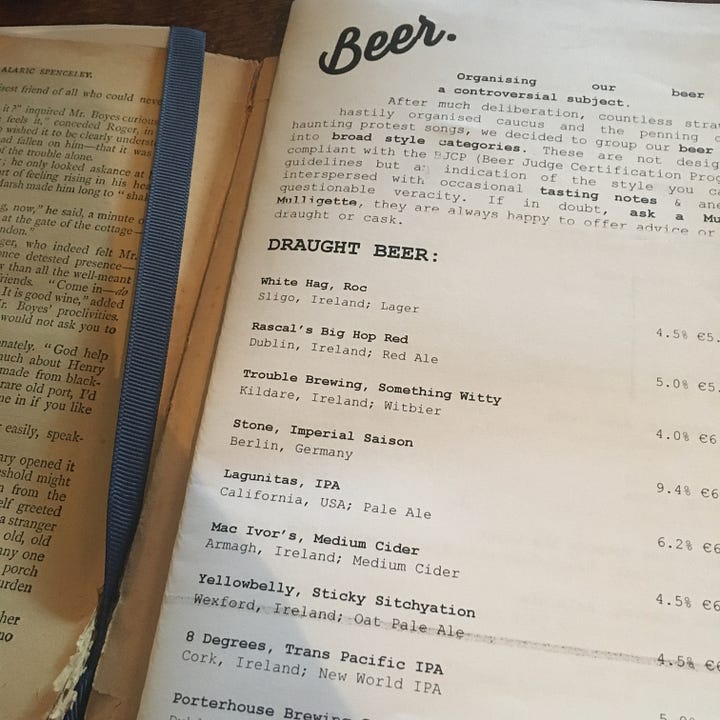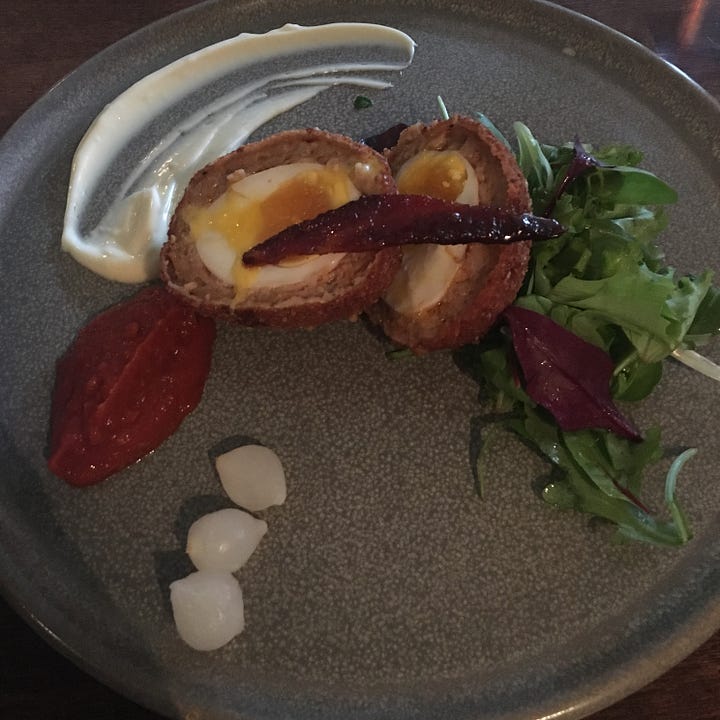If you happened to miss my social media blitz: I started an Instagram account for Grazing. (God, I hate self-promotion, and this is all makes me red and twitchy.) I’ll use it to share links to newsletters and also to generally drone on about the things I’m cooking, eating, drinking, reading and running into in the world.
I should also probably share that last week, I turned on payments for Grazing. If you’re wondering what that means, the short answer is very little. Nearly everything I write will still be free, with the exception of some occasional bonus recipes, links and recommendations. I added a paid option for two reasons: Several people told me they wanted to pay, and I figured if even one person was kicking me $5 per month, that would hold me about 100 times more accountable to writing here frequently.
Also, it came to my attention that Substack recently sent some sort of “pay to subscribe” email to my unpaid subscribers. That is mortifying! I am from the Midwest! Most of the time I feel like I should be paying all of you to read this! Which is to say: I’m sorry for unknowingly cluttering your inboxes.
One reason I went silent with this newsletter for nearly a year — apart from the gazillion fun and overwhelming things that happened to me in 2022 — was I felt I needed to take another step in the kitchen. I was fairly confident I could write better than the average Internet creature, but at some point, everyone (even the most nostalgic among us) runs out of passably witty food-related stories. I was nearly as confident in my cooking; give me a highly-rated recipe from a trusted chef, and I can make it, jot down some tips and tell all 700 or so of you that yep, it’s definitely worth having for dinner. But how hard is that? To write a food newsletter people would read (and I’m talking here about people other than my parents, husband, in-laws and six closest friends), I knew I needed to be able to do more.
So for the past year, I spent a lot of time thinking about what I like, what I don’t like and all the food that falls between those two extremes. How might I make myself like something more? Make it crispier? Make it sweeter? Saltier? Less salty? Up the spice? Change the cooking method? I started making recipes with mixed reviews, the ones that have 2,000 comments in which half the people are like, “I loved that this was for chicken cacciatore, but I actually switched all the spices to stuff sourced from Central America and turned it into pupusas!”
Sometimes, a mixed-review recipe are fine as is, simply a victim of finicky tastes or a horde of bad cooks with sharpened forks. A lot of the time, though, I’ve taken one bite and immediately understood the compulsion to riff — though I promise to keep my recipe development confined to this space, not buried in a thread of people arguing over whether there’s a case to be made for using low-fat dairy products in mac and cheese. (There’s not.)
Over the past year, I’ve followed hunches. I’ve messed up. I’ve made dry muffins and ugly cake and disheveled meatballs. But I’ve also come up with some pretty delicious meals I’m really excited to share, starting with this one:
citrus-soy braised pork with coconut rice
serves 6-8 (and makes great leftovers!)
For the pork:
4 pounds pork shoulder, cut into three equal-sized hunks
⅓ cup tamari
¼ cup fish sauce
¼ cup rice vinegar
¾ cup water
⅛ cup sesame oil
8 cloves garlic
2 teaspoons grated ginger
1 ½ teaspoons green yuzo kosho
zest and juice of 2 limes
zest and juice of 1 orange
1 ½ teaspoons five spice powder
4 tablespoons coconut sugar
a large pinch of red pepper flakes
4 scallions, sliced thinly
For the rice:
1 cup jasmine rice
1 cup coconut milk
1 cup water
a large pinch of red pepper flakes
//1// Heat your oven to 300°F, and place the pork in a large Dutch oven with a lid.
//2// In a medium-sized bowl, whisk together the tamari, fish sauce, rice vinegar, water and sesame oil until the oil is somewhat emulsified. Next, add the garlic, ginger and yuzu kosho, along with the zest and juice of the limes and orange. Whisk again to combine, then add the five spice powder, coconut sugar and red pepper flakes, and whisk some more.
//3// Pour the resulting braising liquid/marinade/potion/whatever you want to call it over the pork in the Dutch oven, making sure it coats each piece and gets underneath all the meat. Spoon some of the marinade that’s pooled in the Dutch oven over the top of the pork.
//4// Cook the pork, covered, for two hours. At the two-hour mark, increase the oven temperature to 325°F and flip the pieces of pork. Cook for another hour, covered, at which point the meat should shred easily with a fork.
//5// Remove the pork from the Dutch oven. There will be a fair amount of braising liquid left behind. Turn on a burner on medium heat, and as the liquid heats, scrape any browned bits from the bottom of the pan. Let the liquid simmer and cook down for about 10 minutes, stirring occasionally.
//6// Meanwhile, combine the rice, coconut milk, water and red pepper flakes in a medium-sized saucepan and bring the mixture to a simmer over medium heat. Lower the temperature to medium-low or low (you want just slight simmering) and cook for 15-20 minutes, until all the liquid is absorbed.
//7// During all this simmering, shred the meat using two forks.
//8// You should be left with somewhere around a cup and a half of braising liquid in the Dutch oven after those 10 minutes. If you have a ton more, you may want to simmer it longer or simply discard some. Add the shredded pork back to the Dutch oven and let it soak in the liquid and cook in its own fat for about five minutes, stirring constantly.
//9// Serve the pork on a bed of rice, and top it with sliced scallions.
Notes: There’s no need to trim the pork fat, unless you get a particularly chonky cut. Tamari looks a lot like soy sauce but is less salty and has a mellower flavor. Do not (do not, do not, please do not!) use soy sauce as a substitute. Do not salt the meat, either. This recipe walks a fine line between really flavorful and too salty, so consider hiding your salt while you cook so you’re not tempted. And if you don’t have any yuzu kosho, you can definitely do without — but it’s really easy to order and extremely delicious.
Friday was St. Patrick’s Day, a holiday my very Irish grandfather, Jim Noonan, mostly detested. He also hated Notre Dame for the same reason: Both the holiday and the school, he’d say, were much too obvious about their Irish-ness. In retrospect, he just may have been a contrarian. He did prefer gin to beer.
Back to the point: While not celebrating on Friday, I found myself thinking back on my one trip to Dublin, in the spring of 2017, and a pub I visited called L. Mulligan Grocer. I’d read online, somewhere, that it had one of the better craft beer selections in Dublin, and at the time, craft beer accounted for roughly 90 percent of the alcohol I drank. The place ended up being total Joan catnip; there were suggested beer pairings with every food item on the menu, and those menus were pasted inside old books. Old books!


It was there that I ate my first (and only) Scotch egg, which is one of the few foods that’s ever stumped me. As in: Who came up with this, and why, and could it have possibly tasted good on the first 100 tries? Sure, the Scotch egg in question tasted great, but I just couldn’t fathom how anyone had gotten from sausage, egg and hot oil to… this. The Scotch egg in question that day had a celeriac remoulade on the side, along with some pickled onions, greens and (I think) candied bacon. There wasn’t a lot not to like, once I got past the incongruity of it all.
I’d love to get back to Dublin soon, and I’d love to have another meal — and a few more beers — at L. Mulligan Grocer.







